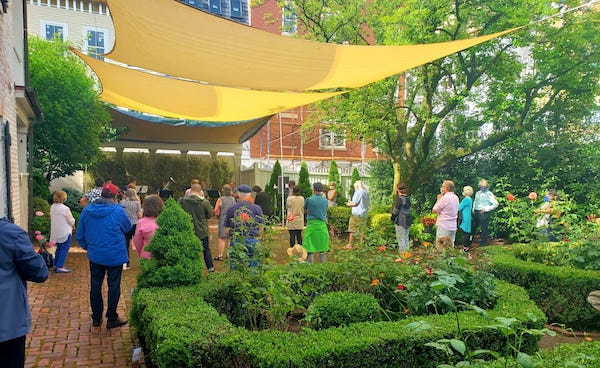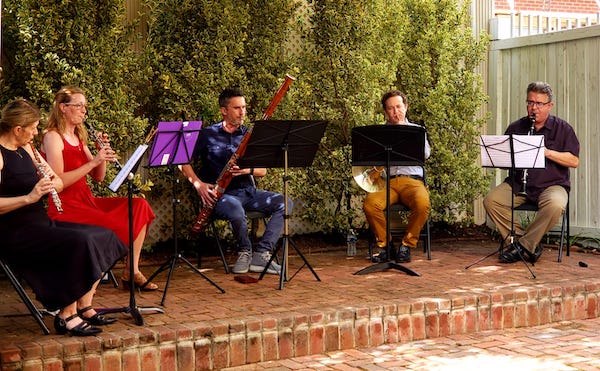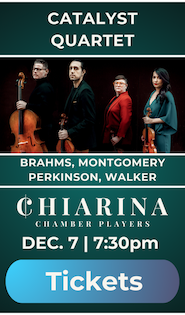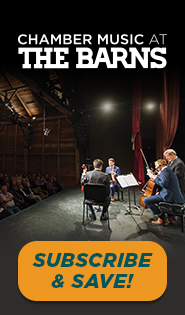Live music returns, offering a preview of the new concert normal

At 5 p.m. Saturday evening, something extraordinary happened: a group of people gathered to hear another group of people play classical music on their instruments.
It was the first time this critic has participated in such an event since early March. What a difference in perspective just three months can offer during a pandemic. Rain had scuttled the three concerts scheduled for the morning, but the skies cleared just in time for the first one in the evening.
The venue was the garden behind the Rectory, the historic Alexandria house that now serves as residence of Classical Movements—a company that in normal times arranges tours for musical ensembles. With all of its touring cancelled, the organization put together a one-day series of one-hour outdoor concerts, featuring musicians from the National Symphony Orchestra, Barclay Brass Quintet, and the Alexandria Symphony Orchestra.
It is a sign of how the Covid-19 pandemic has altered everyday reality that the first question most people want to know about attending such an event is, “Is it safe?”
The presenter took every possible precaution, beginning with holding the performance outside, under the trees walled off near historic Christ Church in Old Town. The audience for each concert was limited to 48 people, who were required to stand at places six feet apart, designated by numbered flags in the ground.
Everyone, except the musicians when performing, wore masks, and the stage where the musicians played was an even greater distance from the first row of listeners. Hand-sanitizer stations were available by the entrance, and the staff followed strict protocols on wiping down the chairs with disinfectant as the musicians changed positions between sets. Risk is all around us these days, but the dangers posed by the coronavirus felt about as mitigated as they could possibly be.
The program was a pleasant mixture of chamber music and chamber-sized arrangements of standard classical fare and more popular music. In normal times it would be the sort of outdoor summer concert one took for granted. After a 15-week drought of live music, however, it packed a punch for the ears, clearing out the dust and infusing most listeners, who tapped their toes and even danced in place, with aural effervescence.
Outdoor concerts are properly the realm of brass and woodwind players, and such groups excelled in this performance. Guest trumpeter Amy McCabe starred with a gleaming tone and polished execution in the diverting Sonata for Horn, Trumpet, and Trombone by the young Francis Poulenc. Along with horn player Robert Rearden and trombone player David Murray, both from the National Symphony Orchestra, they rollicked through the antic third movement, a slalom course of chromatic twists and turns.

A woodwind quintet from the National Symphony Orchestra contributed another intriguing bit of repertory with Umoja, a placid work of gently rocking rhythms by Valerie Coleman, the flutist from Imani Winds. Carole Bean added a pleasant frisson on the flutter-tongued flute parts. This was paired with a slightly awkward arrangement of Maple Leaf Rag by Scott Joplin, rounding out a brief set of music by African-American composers.
A string quintet from the Alexandria Symphony Orchestra offered two movements from Mozart’s Divertimento No. 1. The humidity in the air following the day’s long rain storms made tuning difficult, but Claudia Chudacoff, the ASO’s concertmaster, shone on the first violin parts especially. The grotesquerie of Shostakovich’s Polka, from the ballet The Golden Age, seemed to suit the pandemic era to a tee.
The Barclay Brass Quintet, made of members from a number of local orchestras, bookended the concert with more unusual flavors. Filling in for some of the brass players from the Alexandria Symphony Orchestra, who were unable to attend, the group opened with a selection of Giles Farnaby pieces from the Fitzwilliam Virginal Book. These charming miniatures, fraught with snappy rhythmic interplay, often featured the two trumpets in antiphonal dialogue.
The group seemed equally at ease in Dixieland pieces, including Benny Goodman’s “That’s a Plenty,” with a fun tuba solo in the trio, and Allen Toussaint’s “Java,” arranged by the quintet’s trombonist, David Miller. The jaunty “Hornpipe” movement from Handel’s Water Music, outdoor music par excellence, and an arrangement of Bizet’s “Toreador Song” from Carmen completed the evening’s entertainment with zest.
It was possible at moments during this concert to imagine a time when listening to live music would again be common and something normal. The format offered one feasible way forward for now, although the limitations were obvious, as the humidity cloyed and one shifted from one leg to the other, while jets roared periodically on the flight path overhead. This type of concert could never replace real listening in an indoor hall, but it surely offered a temporary respite on the way to that goal.



